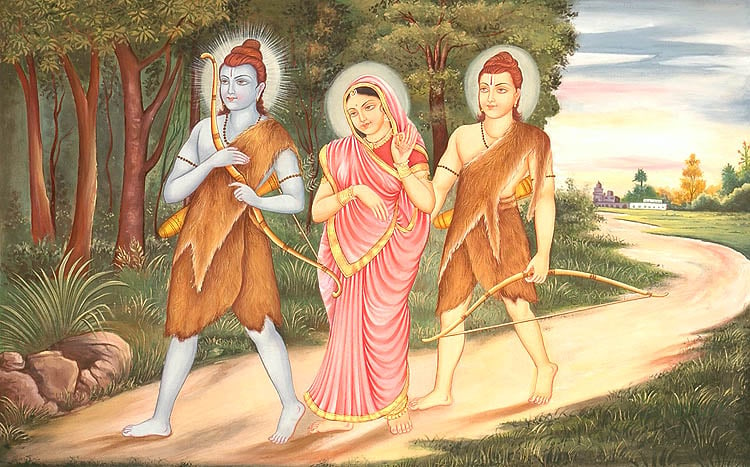Introduction to Ram Navami
Ram Navami celebrates the birth of Lord Ram, the seventh incarnation of Lord Vishnu, revered as the embodiment of chivalry, virtue, and righteousness. This auspicious festival falls on the ninth day (Navami) of the Shukla Paksha in the Hindu month of Chaitra.
Lord Ram is one of the most adored deities in Hinduism, often depicted holding a bow and arrow, symbolizing his readiness to destroy evil. His life story is narrated in the epic Ramayana, where he exemplifies perfect moral values, ideal kingship, and devotion to dharma.
As Swami Vivekananda described, “Lord Ram is the embodiment of truth, morality, the ideal son, the ideal husband, and above all, the ideal king.” He is often referred to as “Maryada Purushottam”—the Supreme Man who upholds righteousness.
2. Lord Ram – The Ideal Man

Lord Ram represents the triumph of good over evil. His life serves as a guiding light for humanity, teaching duty, sacrifice, and devotion. He was born as the son of King Dasharatha of Ayodhya, a brave and just ruler from the Suryavanshi (Solar) dynasty.
Dasharatha had three queens—Kaushalya, Kaikeyi, and Sumitra—but no heir to the throne. His Kul Guru (family preceptor) was Sage Vashishta, who guided the royal family in matters of dharma and governance.
3. King Dasharatha’s Dilemma
One day, Guruma Arundhati (Vashishta’s wife) visited Dasharatha’s palace with her grandchild. Seeing the child cry, Dasharatha inquired why. Arundhati cleverly replied, “He cries because Vashishta is your Guru, but whom shall I be the Guru of? You have no children.”
Struck by this realization, Dasharatha felt deep sorrow over his lack of an heir. He approached Sage Vashishta for a solution. The sage advised him to perform the Putra Kameshti Yagna, a sacred fire ritual to seek divine blessings for a child.
4. The Divine Yagna and Birth of Lord Ram
Dasharatha invited Rishi Shringi to conduct the Putra Kameshti Yagna. Upon its completion, a divine being (Prajapati) emerged from the sacred fire, holding a bowl of kheer (sacred pudding). He instructed Dasharatha to distribute it among his queens.
- Kaushalya (eldest queen) took the first portion.
- Kaikeyi followed.
- Sumitra, out of love, was fed portions by both Kaushalya and Kaikeyi, symbolizing their unity.
This act of sharing led to the birth of four sons:
- Ram (son of Kaushalya) – Incarnation of Lord Vishnu.
- Bharat (son of Kaikeyi) – Known for his devotion to Ram.
- Lakshman & Shatrughna (sons of Sumitra) – Lakshman was the incarnation of Adishesha (Vishnu’s serpent).
5. The Boon of Ravana and Vishnu’s Incarnation
Meanwhile, the Devas (celestial beings) approached Lord Brahma, distressed by Ravana’s tyranny. Ravana had a boon that made him invincible against gods, demons, and celestial beings—but he had forgotten to ask for protection from humans.
Lord Vishnu, clad in yellow robes and holding his divine weapons (Sudarshan Chakra & Shankha), agreed to incarnate as Ram to destroy Ravana.
On the ninth day of Chaitra, under the Punarvasu constellation, Queen Kaushalya gave birth to Ram at noon. His birth marked the arrival of Dharma (righteousness) to restore cosmic balance.
6. Ram’s Exile and the Battle with Ravana
As Ram grew, he became a symbol of virtue, wisdom, and justice. He married Sita (incarnation of Goddess Lakshmi) and was set to be crowned king. However, Kaikeyi, influenced by her maid Manthara, demanded that Ram be exiled for 14 years and Bharat be made king.
- Ram, Sita, and Lakshman went into exile.
- Ravana kidnapped Sita, leading to the epic battle of Lanka.
- Ram defeated Ravana, rescued Sita, and returned to Ayodhya, where Bharat gladly returned the throne.
7. Celebrating Ram Navami – Rituals and Significance
Ram Navami is a vibrant and spiritually significant day observed with great reverence across India and in Hindu communities worldwide. This festival not only celebrates the birth of Lord Ram but also marks the culmination of a nine-day fasting period known as Chaitra Navaratri. The rituals performed are profound and varied, deeply rooted in Vedic traditions, aiming to honor Lord Ram’s divine qualities.
Morning Purification
Devotees begin the day with a ritual bath, often in a holy river, if possible, to purify the body and spirit. Dressed in clean, traditional attire, they prepare for a day of solemn devotion.
Puja and Abhishekam
A special puja (worship ceremony) is conducted at home or in temples. The idol of Lord Ram is bathed (abhishekam) with panchamrita, a mixture of milk, honey, sugar, yogurt, and ghee, symbolizing purification and sanctification. After abhishekam, the idol is adorned with new clothes, typically a bright yellow fabric, symbolizing purity and renewal.
Offerings
Devotees offer a variety of items to Lord Ram, which include flowers, especially the lotus as a symbol of purity and spiritual power; fruits, which represent devotion and surrender; and sweets, which signify the sweetness of devotion. Tulsi leaves are also offered, considered particularly sacred in worshiping Vishnu and his avatars.
Fasting
Many devotees observe a strict fast on this day. This fast is typically broken at the end of the day with a prasad of fruit and sweets distributed among family and community members. The fast purifies the body and mind, aiding in spiritual growth and self-discipline.
Recitation of Ramayana
The epic story of the Ramayana is recited during Ram Navami. Temples and community centers host readings of the Ramayana, drawing families and communities together to re-enact and listen to the deeds of Ram, which teach lessons of duty, devotion, and righteousness.
Chanting and Meditation
The recitation of ‘Ram Naam’, or the name of Ram, is a common practice. Chanting is believed to enhance spiritual energy and provide peace to the chanter. Meditation on this day focuses on the qualities of Lord Ram, fostering inner peace and spiritual enlightenment.
Charity (Daan)
In the spirit of Lord Ram’s compassion and generosity, devotees engage in acts of charity. This includes distributing food to the needy, donating clothes, and providing other forms of help to those less fortunate. This act of giving is seen as a crucial part of personal and spiritual development.
Cultural Performances
In many regions, especially in North India, Ram Navami is celebrated with elaborate performances of the Ramleela, dramatic re-enactments of episodes from Ram’s life. These performances are not just entertainment but a medium for spreading moral and ethical principles.
Conclusion
Ram Navami is more than just a festival; it’s a day filled with deep religious significance and joyful celebration, embodying the virtues of Lord Ram. It serves as a reminder to live a life of righteousness and to strive for spiritual growth in accordance with dharma. Through its rituals, it offers a chance to renew one’s faith and reflect on one’s actions and thoughts in the pursuit of truth and righteousness.





